Much has changed since 1958. Back then the average cost of a new house in America was $12,750, and a gallon of gasoline would set you back 25 cents. Eisenhower was President, and Elvis had just joined the Army. Jack Kilby and Robert Noyce invented the microchip, and the whole earth moved just a little bit as a result. What a difference fifty years can make.
Today’s latest M4A1 Carbine is the end result of more than half a century of martial evolution. From morphology to metallurgy, the Carbines our boys and girls carry into combat today bear little semblance to those primitive M16 rifles their grandfathers wielded in the early stages of the Vietnam War. While forearm rails and electronic optics are de rigueur these days, it can be a fascinating exercise to look backward and see where it all came from.
In the Beginning…
The origin story is foundational dogma for gun nerds like us. George Sullivan incorporated the ArmaLite Corporation in 1954 as a tiny little subsidiary of the Fairchild Engine and Airplane Corporation. Operating out of a modest machine shop in Hollywood, California, Sullivan envisioned ArmaLite as a think tank to explore cutting-edge concepts in small arms. Their first serious effort was a small takedown survival rifle intended for use by downed military aircrew.
While out test firing this prototype rifle on a local firing range Sullivan bumped into Gene Stoner. A World War 2 Marine veteran, Stoner had a vision to incorporate aviation technology into the field of small arms. A friendship was born and Sullivan hired Stoner as his chief design engineer. As of 1956, ArmaLite had a grand total of nine employees.
The resulting guns were indeed radical. Employing aircraft aluminum receivers and phenolic synthetic furniture, these early ArmaLite rifles were justifiably compared to the science fiction weapons of the day. Employing a gas-operated, magazine-fed action and inline architecture to help manage recoil, these earliest black rifles were shadows of the great things that were to come.

This modern retro replica of a Model 602 M16 is almost but not quite perfect. It is amazing how lightweight these old guns were before we started hanging so much stuff off of them.
The AR10 fired 7.62x51mm ammunition and was exceptionally lightweight. That earliest prototype weighed a mere 6.86 pounds empty. This radical rifle was briefly pitted against the T44 and T48 in the contest to select the US military’s new Infantry arm. The T44 became the M14, and the T48 was an Americanized version of the FN FAL. While the AR10 fizzled in 1957, events were unfolding in both Washington DC and Southeast Asia that were destined to tie the ArmaLite design to the United States Military for generations to come.
The AR10 was built under license in the Netherlands for a time and saw action with Portuguese Special Forces in Africa. Eventually, the basic AR10 action was scaled down to accept a .223 cartridge for what was called the CONARC trials. CONARC stood for Continental Army Command, and these tests sought to select a new lightweight combat rifle that would be both easy to carry and controllable on fully automatic. In 1958 ArmaLite submitted ten rifles and one hundred 25-round magazines for the tests. Though the compact bantamweight weapons performed well, internecine political squabbles conspired to torpedo the lithe little gun. Frustrated with the lack of progress, ArmaLite sold the rights to the AR10 and AR15 off to Colt.
A lot of fairly tedious political stuff happened at this point that we will ignore in the interest of brevity. Ultimately the new type-classified M16 made its way to Vietnam for troop trials. Those earliest M16’s fell into several broad developmental categories based upon various arcane technical details. With the recent interest in everything retro, a cottage industry has arisen around sourcing parts to build modern-day replicas of these exceptionally rare guns. The rifle we will dissect today is most closely described as a semi-auto replica of a Model 602 M16. Some of the details are not quite perfect, but it is awfully close.
Early Morphology
From nose to butt our replica Model 602 M16 sports a three-prong duckbill flash suppressor. There were two major variants, and the one on my rifle is the first. Early barrels sported a 1-in-12-inch twist rate and were not chrome lined. Front sights had a round cross-section and could technically be adjusted for elevation using the nose of a bullet. There were tiny variations in gas block markings, but I cannot dredge up enough enthusiasm to care.
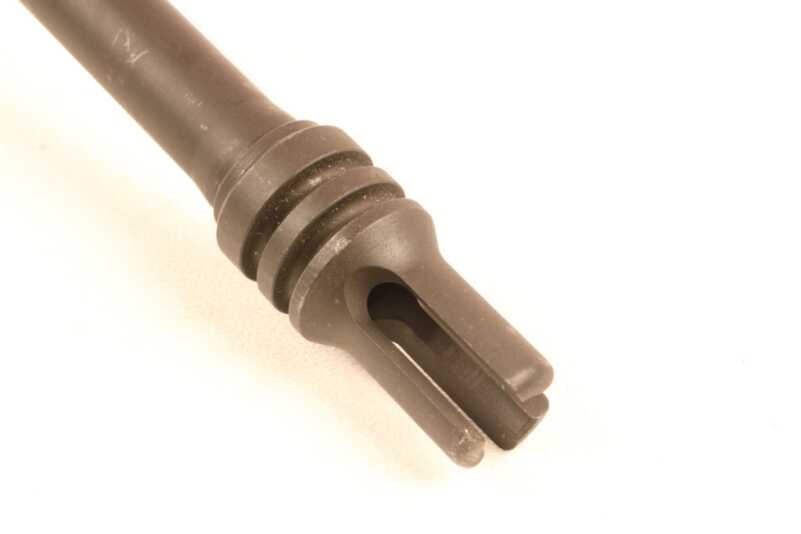
This first model duckbill flash suppressor sports open prongs that were notorious for catching on stuff in the jungle.
The triangular synthetic handguards were initially painted green before being ultimately left black. They came in dedicated left and right-hand versions and included pressed steel heat shields. The furniture on my rifle is original early Colt and was painstakingly sourced. Those early slip rings were straight-walled and fairly difficult to manage.

These original early Colt triangular handguards include steel heat shields and are secured via a straight slip ring.
Early upper receivers lacked a forward assist device and included a simple flip-adjustable peep sight. This sight was adjustable for windage via a bullet tip. An aluminum carrying handle was formed as an integral part of the upper receiver assembly.
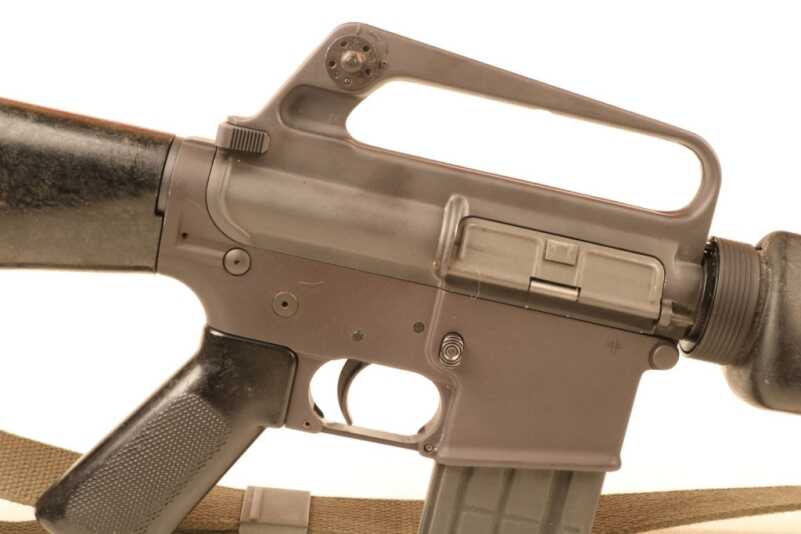
The original slab side M16 receivers lacked a raised fence around the magazine release catch. The forward pushpin was also not captive.
The lower receiver was flat on both sides, lacking the elevated fencing around the magazine release with which we are familiar today. The forward pivot pin included a detent in the pin itself but was not positively retained, so it could be easily lost. The charging handle had a fairly small triangular gripping surface. The bolt and bolt carrier were hard chrome plated, and the firing pin retaining pin was a specifically manufactured component rather than a standard cotter pin.

Very early charging handles had a small-ish triangular serrated gripping surface. Later versions are much easier to use.
The buttstock was solid and lacked a trap for cleaning gear. The earliest rear sling swivels pivoted, while later versions were rigid. The earliest Edgewater buffers included a series of washers not found on subsequent designs.
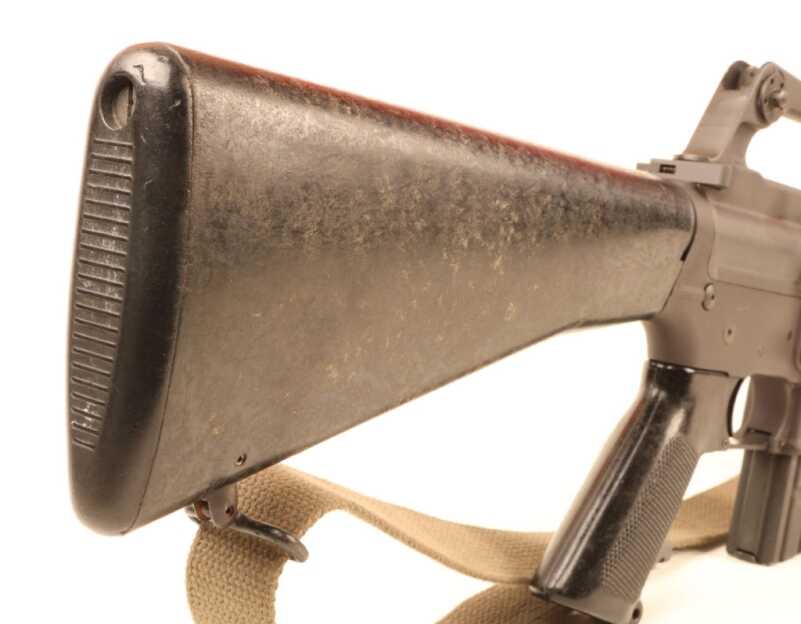
The first M16 buttstocks lacked a trap compartment for cleaning supplies and sported a freely mobile rear sling swivel.
While those earliest M16 magazines were straight-walled and carried twenty-five rounds, the first general-issue mags were imbued with a waffle pattern and took twenty. Early AR10 magazines sported a similar design. Followers were short and prone to tilt.

The singular best improvement to the M16 over the years has been in its magazine. From left to right, an early 1950’s-era 20-round AR10 waffle mag, a later AR15 20-round waffle magazine, a Vietnam-era Colt 20-round M16 box, and an Information Age 30-round P-Mag.
Trigger Time on the 602
It is amazing how lightweight these old rifles were before we started hanging stuff all over them. This primitive M16 clone weighs just a hair over what an M1 Carbine might while throwing a much more effective round. Recoil is mild, and follow up shots are fast. While my retro clone is semiauto only, I have run a few zillion rounds through similar GI full auto M16A1 rifles back when I was young, bulletproof, and immortal. Those guns do not well suffer sloth when the Happy Switch is set to the Hallelujah position. However, if you lean into the rifle, use proper technique, and keep your bursts to a reasonable length the gun remains a formidable close combat tool.
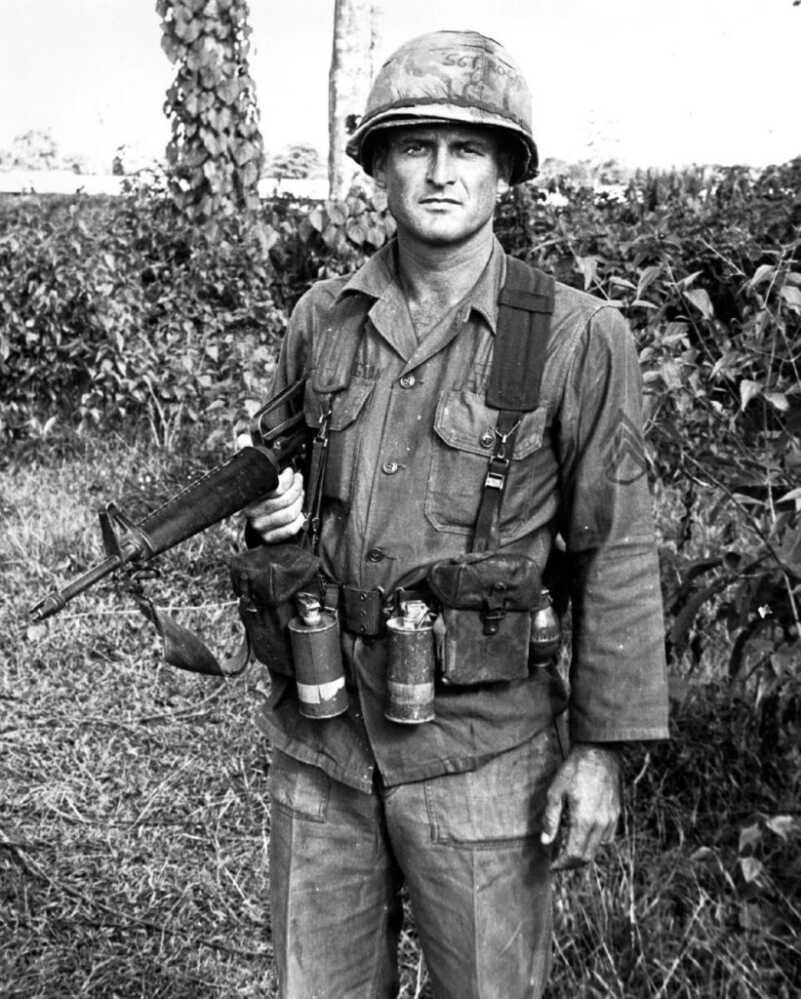
The earliest model M16 rifles used in Vietnam sported three-pronged open flash suppressors and lacked a forward assist device.
The simple flip-adjustable peep sights seem crude compared to modern electronic optics, but they were light years ahead of most World War 2 designs. Adjusting the sights while zeroing the rifle was a chore without a dedicated aftermarket sight adjustment tool, but I kept one in my LBE (Load Bearing Equipment) that I was always willing to share. The general layout of the M16 interfaces unnaturally well with the human form. While much about the gun has changed, the basic switchology remains the same.
Back when I had good eyes I could consistently shoot expert out to nearly half a kilometer with a rifle very similar to this one. Running a few rounds through this nifty little gun brings back lots of memories. The distinctive twang sound as the buffer cycles millimeters from your face is like the voice of an old friend.
So Why Did They Change Everything?
The three-prong open-ended flash suppressor was great for prying open the wire around ammo crates, but it was notorious for catching on vines and such when moving through thick brush. If you’ve never had the pleasure of humping the boonies with a weapon for real you develop a oneness with the environment that really has no civilian parallel. I once saw a young man unwittingly carry a dead lizard that was nearly twelve inches long around in his BDU shirt for half a day. It was simply that he was so filthy he did not realize the unfortunate creature had crawled down his shirt and then been crushed to death by his rucksack. That poor guy looked like he was having a seizure when first he realized he had been walking around all night with a foot-long dead reptile curled up in his armpit. I don’t know about anybody else, but I first joined the Army for the glamor.

Early M16 rifles were by all accounts very successful in the hands of Special Forces and indigenous troops in Vietnam. Subsequent changes to ammunition propellant and the lack of proper maintenance gear and training precipitated a disaster.
Those thin raw steel barrels have been beefed up, chrome-lined, and had their rate of twist tightened. The many-splendored impact this has had on lethality would fill a textbook. Bullet design has evolved substantially since then as well, but nobody will ever be happy with it all.
The triangular handguards were slippery when wet and prone to breakage. The newer round versions we used before everybody bought forearm rails were tougher and interchangeable, so it was easier on the supply guys. The straight slip ring grew a taper, so it was easier to manage.

US Army Special Forces serving in Vietnam were some of the first American troops to use the M16 operationally. Note the three-pronged flash suppressor and slab-sided upper receiver.
Modern M4 rifles traded their carrying handles for Picatinny rails, so our current crop of kids serving downrange can see farther and shoot faster than old geezers like me ever could. Modern iron sights are much easier to adjust without tools, though I have not personally ever seen anybody use them as intended at long ranges. Today’s bolt carriers are not so shiny as was once the case, and stepped-up extractor springs are hugely better than they used to be. Today’s charging handles are much grippier than those earlier sorts, and the rigid rear sling swivel always looked to me like it would carve somebody’s face off if you used it for a proper butt stroke.
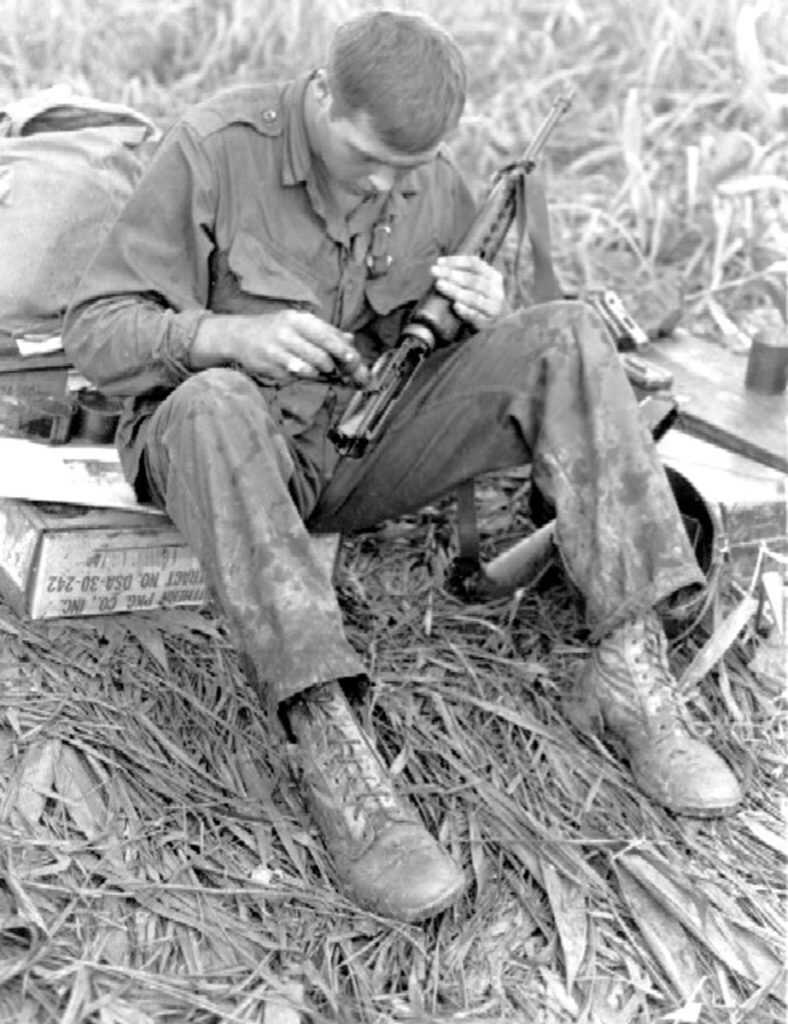
Once the M16 rifle had matured somewhat and was subjected to proper maintenance it became a reliable and effective combat tool.
I have had an errant tree branch center punch my mag release while crawling through brush and drop my magazine, but the raised fencing makes that unfortunate event much less likely.
Anything that comes off the rifle is something you can lose. Today’s captive takedown pins are an enormous improvement. The 1911 pistol is indeed an inspired contraption. However, I once saw a young stud launch his recoil spring plunger into the stratosphere while stripping the weapon in the field. That thing is still likely out in space somewhere orbiting the sun.

The lack of cleaning gear and basic rifle maintenance training resulted in poor performance for the M16 early in its operational life.
90% of the many stoppages I encountered with those old M16A1 rifles stemmed from that repugnant stubby magazine follower. Those early magazines were notorious for allowing the round stack to tilt and produce a bolt over base stoppage. Compared to those old boxes a P-Mag is an incalculable improvement.
Ruminations
This particular rifle has an interesting story. The gentleman who built it acquired the various components from a dozen different sources over months of searching. The end result is a simply superb semiauto rendition of an early Model 602 M16. However, this guy had the profound misfortune to live in the People’s Republic of California. The laws changed, and he had to sell the rifle to somebody living in the Free States. I felt like I was taking receipt of an abandoned child.

Today’s modern M4A1 Carbine stemmed from the original 1956-era AR10. This gun was built up from an imported Dutch parts kit on a domestically produced receiver.
Today’s state-of-the-art M4A1 sprouts lights, lasers, and holographic optical sights unimaginable a generation ago. The beating heart is the same simple direct gas impingement operating system that you either love or hate, but most everything else about the gun is fresh, new, and different. The changes we have seen in the M16 platform over the past half century are well-reasoned and effective. Until the BlasTech E11 Stormtooper blaster becomes widely available the venerable M4 will still keep soldiering along. More than most any other contemporary mechanical contrivance, in the M4 we see the most overt evidence of martial evolution in action.

The 1960’s-era M16 rifle has come a long way in half a century. While the beating heart is unchanged, the external morphology is all but unrecognizable.
Technical Specifications
Model 602 M16
Caliber 5.56x45mm
Action Direct Gas Impingement
Barrel Length 20 inches
Overall Length 39.5 inches
Weight 6.37 pounds
Feed System 20-round Detachable Box Magazine
Rate of Fire 700-950 rounds per minute
Performance Specifications
Model 602 M16
Load Group Size (inches) Velocity (feet per second)
American Eagle 55gr FMJ 1.6 3091
American Eagle 50gr JHP 3.6 3372
HSM 55gr Sierra Blitzking 1.2 2976
SIG 60gr HT 5.6** 2605
**These rounds seemed to keyhole. Apparently, the old slow twist barrel was inadequate to stabilize them.
Group size is the best four of five shots measured center to center and fired from a simple rest at 100 meters. Velocity is the average of three shots fired across a Caldwell Ballistic Chronograph oriented ten feet from the muzzle.

These Vietnam-era rifles are on display in the National Firearms Museum. This collection includes a prototype ArmaLite AR10 as well as a pair of early M16 variants.
***Shop GunsAmerica for your next M16 variant***



I carried the M16A1/203 combo for my entire 8 yrs. active and another 9-10 in Army Reserves. I was trained to clean my weapon after every range, and after the couple fire fights I had the misfortune to be part of. Never ever had an issue with my weapon the entire time.
Fast forward a shitload of years I built an AR15 semi carbine length, sure wish I had had a carbine when I was active, I like the shorter barrel still accurate out to 200 meters where I have it sighted in at. Never had the suppressor and the Eotech and all the other makes & models hadn’t even been thought of then, nor the rail where you can attach all manner of gadgets to assist one in taking out your enemy. Bet your ass I got all that neat stuff on my AR now. Thinking on changing out the aluminum handguard with the attachment rails on it,(forgive me, my brain isn’t what it used to be, suffer from TIA’s as a result of Dessert Storm activity). I can still shoot & can tear down my AR along with my 45 & 9 mm pistol can remember all that shit, just not what happened a year/6 months/ a week ago. SIGH….sometimes getting old really sucks, beats the alternative!
U.S.Army
U.S. Army Reserves
1975-1992
SSG (ret)
In the photo with subtext:
‘The 1960’s-era M16 rifle has come a long way in half a century. While the beating heart is unchanged, the external morphology is all but unrecognizable’.
What is the item on the modern accessorized rifle on the top rail between the front sight and the optical sight? Is it a backup rear ‘iron’ sight that is moved to the rearmost position on the rail if the optical sight fails and is removed?
Thanks,
Grenade launcher sight for the M203 launcher under the rail.https://en.wikipedia.org/wiki/M203_grenade_launcher
I am also a product of 1958, and that would be 60 years.
I concur. The original M16A1 was not ready for prim time (it had a forward assist).
The magazine would also double feed if filled with 20 rounds.
A little piece of trash in the chamber would cement that brass case in place, you could slam the butt stock into the ground and get it to rechamber a new round but pulling on the charging handle would rip the case head off leaving the brass in place.
I don’t think I would butt stroke anyone unless I was out of ammo though.
I was lucky in that it performed when I needed it. I was a radio operator and the M16A1 was one hell of a full auto pistol when my radio was in my other hand.
Vietnam 1967-1969 3rd MarDiv 2/4 Fox co
As a !st Cav LRRP, I was first issued a CAR-15, which jammed in my first ever firefight. I survived and upon extraction, I asked for a replacement and was issued a new M16A1 which I carried for the rest of my tour. I put twenty 18 round mags through it that day and again the next day. Cleaned it since I was not taught not to and slapped LSA all over it and never had a malfunction. I bet my life on that rifle many times and it never failed to hit where I wanted it to. I have a semi auto replica I built and it is my favorite ar. Rifle length barrel shoots better than the carbine too.
I found the trhee prong flash hider handy for opening cases of C-rations. Worked great as a wire cutter.
I know it’s unfair to pick on authors for mistakes in pictures they use, but whoever set up that suppressed M4 for a side-by-side with the early-style AR should be sent back to playing “Call of Duty” unless their hands are big enough to actually aim and fire that M203 with those paired magazines in place.
Why? You’re not holding the mags?!
During the Vietnam conflict, the Vietnamese had their own jungle gunsmith shops cranking out copies of Stens, AK47’s and Thompson SMG’s and a host of other weapons. The M16 was not one of those guns copied. Later with the fall of Saigon, M16s captured there had no inherent value to anyone. That said, the AR15 became popular as a sporting arm here in the states and as a civilian model it proved to be a good pick right next to the Ruger Mini-14.
The military has had 60 years to test, and 50 years to improve the M16 design no different than most weapons. The thing is, of all the military weapons I’ve ever seen the AK-47 has been the most resilient and capable of operating in just about any environment. Not to knock the M16, but head to head, probably half the soldiers in Vietnam would have probably wanted an AK-47 for reliability.
Dear Mr Dabs. Ten years ago it was 50 years. 1958 was SIXTY YEARS AGO. Just tell my brother who will be sixty in a few weeks. I told him it did not hurt that bad but he’s still mopey about it.
Am I missing some other context here? “What a difference fifty years can make.” 1958 to 2018 is 60 years of development.
Just wanted to comment that the original M16 was a piece of junk! An unreliable “jam-o-matic” rifle that was defintely “not ready for primetime” and surely accounted for numerous GI deaths/injuries. The biggest problem (IMHO) was the incredible lack of any means of pushing the bolt forward/in battery. If you had a round that failed to be properly chambered/loaded and could not be ejected by pulling back the bolt you were faced with manually ejecting the round with a knife/cleaning rod etc. Try THAT one in the middle of a firefight! Add to this the tendency to jam even though the rifle was pristinely clean with new ammunition (later found out to be greatly due to the use of old WW2/Korean era gunpowder that was wrong for the M16), a too high rate of auto fire (we were later issued different buffers to slow it down), limited to 20 round magazine and a bullet that appeared to often have problems penetrating bushes/brush. I requested that I be allowed to carry an M14 but was turned down. I had ZERO confidence in the 1966-67 version M16! I remember reading (years later) that the M16 had even failed to successfully pass the weapons testing normally done for weapons being considered for military issuance. The too tight rifling retained water (due to capillary action) that resulted in barrels failing when fired. I gather that in the years since then a forward assist handle (to close the bolt) was added, the powder problem resolved, the barrel/rifling changed and other improvements made that have resulted in the present day M16 being a reliable weapon. Never heard any real noise or punitive action about the issuance of the fiasco of a rifle that was the early M16. Only wish someone had waited a while longer before forcing it on so many good soldiers whose lives depended on it. Just my .02 cents.
TD Vietnam Vet 101st Airborne
Sounds like another government SNAFU. Imagine that.
I and many others humped an M14 back in `66 & `67 just because of reliability issues of the M16. The M14 was heavy, yes, but damn it was accurate and very lethal at most any range. Also carried a M79 on occasions. That M203 is sweet, would have been nice back in the day. My son swears by the M4, however he’s never fired an M14.